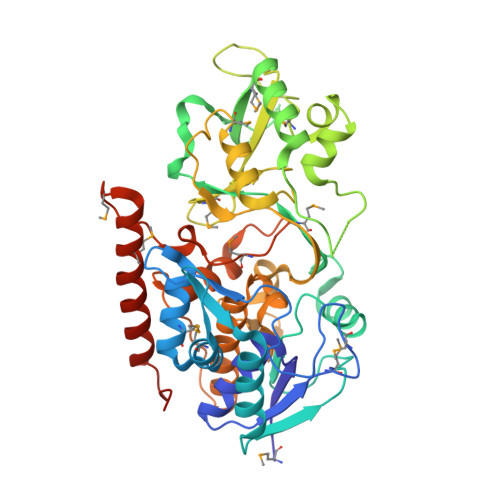Atomic structure of a folate/FAD-dependent tRNA T54 methyltransferase
Nishimasu, H., Ishitani, R., Yamashita, K., Iwashita, C., Hirata, A., Hori, H., Nureki, O.(2009) Proc Natl Acad Sci U S A 106: 8180-8185
- PubMed: 19416846
- DOI: https://doi.org/10.1073/pnas.0901330106
- Primary Citation of Related Structures:
3G5Q, 3G5R, 3G5S - PubMed Abstract:
tRNAs from all 3 phylogenetic domains have a 5-methyluridine at position 54 (T54) in the T-loop. The methyl group is transferred from S-adenosylmethionine by TrmA methyltransferase in most Gram-negative bacteria and some archaea and eukaryotes, whereas it is transferred from 5,10-methylenetetrahydrofolate (MTHF) by TrmFO, a folate/FAD-dependent methyltransferase, in most Gram-positive bacteria and some Gram-negative bacteria. However, the catalytic mechanism remains unclear, because the crystal structure of TrmFO has not been solved. Here, we report the crystal structures of Thermus thermophilus TrmFO in its free form, tetrahydrofolate (THF)-bound form, and glutathione-bound form at 2.1-, 1.6-, and 1.05-A resolutions, respectively. TrmFO consists of an FAD-binding domain and an insertion domain, which both share structural similarity with those of GidA, an enzyme involved in the 5-carboxymethylaminomethylation of U34 of some tRNAs. However, the overall structures of TrmFO and GidA are basically different because of their distinct domain orientations, which are consistent with their respective functional specificities. In the THF complex, the pteridin ring of THF is sandwiched between the flavin ring of FAD and the imidazole ring of a His residue. This structure provides a snapshot of the folate/FAD-dependent methyl transfer, suggesting that the transferring methylene group of MTHF is located close to the redox-active N5 atom of FAD. Furthermore, we established an in vitro system to measure the methylation activity. Our TrmFO-tRNA docking model, in combination with mutational analyses, suggests a catalytic mechanism, in which the methylene of MTHF is directly transferred onto U54, and then the exocyclic methylene of U54 is reduced by FADH(2).
Organizational Affiliation:
Department of Basic Medical Science, Division of Structure Biology, Institute of Medical Science, University of Tokyo, Tokyo, Japan.



















